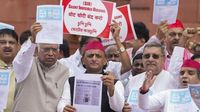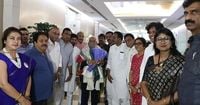With the race for India’s vice-presidency heating up, political corridors in New Delhi have been buzzing with speculation, strategy, and a healthy dose of symbolism. On August 19, 2025, the opposition INDIA bloc finally settled on its candidate for the high office, capping off days of intense deliberation and last-minute negotiations. Their choice: former Supreme Court judge B Sudershan Reddy—a figure with both legal gravitas and a reputation for impartiality. Meanwhile, the ruling National Democratic Alliance (NDA) had already put forward its own heavyweight: C P Radhakrishnan, current Governor of Maharashtra and a veteran BJP leader from Tamil Nadu. The stage is now set for a contest that, while largely symbolic given the NDA’s numerical advantage, carries significant political undertones.
The journey to this moment was anything but straightforward. As reported by The Indian Express and corroborated by multiple outlets, the INDIA bloc’s internal discussions initially revolved around fielding a non-political, consensus candidate—someone with stature and national standing, capable of projecting unity beyond party lines. Names floated included M Annadurai, the celebrated former ISRO scientist dubbed the ‘Moon Man of India’ for his leadership of Chandrayaan-1, Chandrayaan-2, and the Mars Orbiter Mission, and Tushar Gandhi, author and great-grandson of Mahatma Gandhi. There was also talk, according to The New Indian Express, of considering a Dalit leader to broaden the appeal.
The bloc’s choice was shaped as much by arithmetic as by optics. The NDA, which holds a comfortable majority in the 781-member electoral college with 424 members, was always expected to have the upper hand. But the opposition was determined to make a statement. As one senior leader put it, the aim was to “highlight commitment to the Constitution and democracy by fielding a candidate despite the NDA’s numerical advantage.” The symbolism of fielding a candidate with national stature, and not merely a party loyalist, was paramount.
On August 18, 2025, the INDIA bloc’s leaders gathered at Congress president Mallikarjun Kharge’s residence to whittle down their shortlist. Sharad Pawar of NCP (SP) reportedly suggested Tushar Gandhi’s name, while the DMK, keen to counter the NDA’s Tamil Nadu pitch, pushed for Annadurai. The Trinamool Congress (TMC), which had abstained from the previous vice-presidential election out of dissatisfaction with the selection process, was this time insistent on a non-politician. Both Gandhi and Annadurai fit that bill, and TMC sources indicated they’d be satisfied with either.
But as the clock ticked down to the final decision, the calculus shifted. The TMC, wary of turning the contest into a Tamil Nadu-centric duel—since both Radhakrishnan and Annadurai hail from the state—began advocating for a candidate with a broader national profile. Enter Justice B Sudershan Reddy, whose credentials as a former Supreme Court judge and chairman of the Expert Group for the Telangana Caste Census made him an attractive compromise. According to NDTV and The Hindu, the Congress floated Reddy’s name, and with the TMC’s backing, other parties quickly fell in line. By the afternoon of August 19, the bloc had its candidate.
Meanwhile, the NDA’s campaign was already in full swing. On August 18, C P Radhakrishnan arrived in the capital to a hero’s welcome. Senior NDA leaders, including Union Consumer Affairs Minister Pralhad Joshi and Parliamentary Affairs Minister Kiren Rijiju, received him at the airport. Prime Minister Narendra Modi met with Radhakrishnan and publicly lauded his “long years of public service and experience across domains,” posting on X: “His long years of public service and experience across domains will greatly enrich our nation.” The NDA’s outreach wasn’t limited to its own ranks. Defence Minister Rajnath Singh, appointed as Radhakrishnan’s campaign manager, was on the phone with leaders across the political spectrum, including Kharge and Rahul Gandhi, seeking a consensus or at least a cordial contest.
The political crosscurrents ran deep. The DMK, which leads Tamil Nadu’s ruling coalition, found itself in a bind. While the NDA’s choice of a Tamil leader was designed to appeal to regional pride ahead of the 2026 state elections, the DMK was reluctant to back a rival party’s nominee simply on ethnic grounds. “We cannot support Radhakrishnan merely on the grounds that he is Tamil,” a senior DMK leader told The New Indian Express, emphasizing the primacy of “ideology.” Their preference for Annadurai was as much about countering the BJP’s southern push as about showcasing scientific achievement.
Regional dynamics aside, the opposition’s ultimate selection of Justice Reddy was widely seen as a move to sidestep intra-bloc rivalries and project unity. As NDTV reported, Reddy’s background—spanning the judiciary and social policy—offered a unifying narrative. His work as chairman of the Telangana Caste Census Expert Group, set up by a Congress-led government, also gave him credibility on issues of social justice, a core plank for many opposition parties.
The NDA, for its part, continued to press for a unanimous election. Parliamentary Affairs Minister Kiren Rijiju told reporters that Modi had appealed to all parties, “particularly the Opposition, to extend their support so that Radhakrishnan could be elected unopposed.” But with the opposition determined to contest, the prospect of a walkover faded.
As the last date for filing nominations—August 21—approaches, the lines are clearly drawn. The vice-presidential election, triggered by the sudden resignation of incumbent Jagdeep Dhankhar, is scheduled for September 9. The NDA’s candidate is all but assured of victory, but the opposition’s campaign is about more than numbers. It’s about staking a claim to the moral high ground, demonstrating unity, and keeping alive the spirit of contestation in Indian democracy.
Notably, the YSR Congress Party, a key regional player, declared its intent to back the NDA’s candidate. According to The New Indian Express, Defence Minister Rajnath Singh personally reached out to YSR Congress chief Jagan Mohan Reddy to secure this support, further consolidating the NDA’s already formidable position.
In the end, while the outcome of the vice-presidential race seems all but certain, the process has thrown a spotlight on the evolving strategies of both the ruling and opposition alliances. The NDA is leveraging its strength and seeking to broaden its appeal, particularly in the south. The opposition, for its part, is using the contest as a platform to showcase unity, inclusiveness, and a commitment to democratic principles—even in the face of likely defeat.
The contest for India’s vice-presidency this year may not upend the balance of power in Parliament, but it has offered a revealing glimpse into the political calculations and aspirations of both sides. As September 9 approaches, all eyes will be on the symbolic, yet telling, outcome of this high-profile election.





